EDI integration has become an integral part of every business. However, some companies rely on traditional data exchange. So, which is better and why? In this article, we will provide you with all the information about these two methods. So you can make a perfect decision for your business.
Both these methods of data exchange are used by various companies. But they are different in many ways. It is crucial to understand each of them in detail to avoid confusion while selecting a particular one. We will discuss the benefits of both these methods. It might help you in choosing the proper method for your company.
EDI integration is more popular these days because it involves digital systems. The smooth process helps companies to have a smooth data exchange with other business partners. On the contrary, traditional data exchange has been used by businesses for many years. It includes mailing, fax, etc.
The comparison of EDI and traditional data exchange is not challenging to understand. All you have to do is consider your company’s requirements to decide. Let’s discuss everything about these two data exchange methods.

What Is EDI?
EDI is the process of transferring data with various computer systems electronically. It stands for Electronic Data Exchange. Here are some benefits of using EDI for your business:
- Less or zero human errors: As everything is done digitally, you don’t need to worry about errors with traditional methods. No errors mean you can complete the tasks on time, further improving growth.
- Fast processes: The entire process of data exchange by using electronic systems is quick and efficient. You don’t have to worry about the speed, which is impressive.
- Reduced costs: EDI helps lower the cost of data exchange because you don’t need to prepare documents manually. It means you can avoid the costs of paper, ink, and more.
- Improve customer satisfaction: Every company wants to satisfy their customers. With this satisfaction, they can grow more by attracting more people. EDI integration has made this goal convenient for businesses. As the processing of orders is quick, the customers find it more satisfying.

What Is Traditional Data Exchange?
Traditional data exchange is an old method of transferring data to business partners. It involves the use of manual documents. So, you must prepare them before sending them to others through fax, mail, or other traditional techniques. The benefits of it are as follows:
- No extra costs: You don’t need to spend a lot of money to exchange data traditionally. A little bit of investment is all you need.
- Convenient: Manual documents are convenient to prepare and send. It is also easy for other partners to understand it.
- Used by many companies: Many companies still rely on traditional data exchange. Therefore, it is better.

The Bottom Line
From the above information, it is easy to select a particular method. But you have to consider several things before choosing it. These include budget, the volume of data, needs, and knowledge. All these things play a crucial role in deciding a suitable method.





